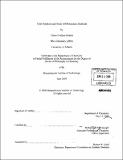Total synthesis and study of myrmicarin alkaloids
Author(s)
Ondrus, Alison Evelynn, 1981-
DownloadFull printable version (15.43Mb)
Other Contributors
Massachusetts Institute of Technology. Dept. of Chemistry.
Advisor
Mohammad Movassaghi.
Terms of use
Metadata
Show full item recordAbstract
I. Enantioselective Total Synthesis of Tricyclic Myrmicarin Alkaloids An enantioselective gram-scale synthesis of a key dihydroindolizine intermediate for the preparation of myrmicarin alkaloids is described. Key transformations in this convergent approach include a stereospecific palladium-catalyzed N-vinylation of a pyrrole with a vinyl triflate, a copper-catalyzed enantioselective conjugate reduction of a P-pyrrolyl enoate, and a regioselective Friedel-Crafts reaction. The synthesis of optically active and isomerically pure samples of (4aR)-myrmicarins 215A, 215B, and 217 in addition to their respective C4a epimers is presented. II. Palladium Catalyzed Synthesis of N-Vinyl Pyrroles and Indoles A stereospecific palladium catalyzed N-vinylation of azaheterocycles with vinyl triflates is described. Cyclic and acyclic vinyl triflates along with non-nucleophilic azaheterocycles were found to be substrates for this palladium catalyzed synthesis of N-vinyl pyrrole and indole derivatives. III. Dimerization of (+)-Myrmicarin 215B. A Potential Biomimetic Approach to Complex Myrmicarin Alkaloids The acid promoted diastereoselective dimerization of myrmicarin 215B is described. The reactivity of these sensitive alkaloids, structural assignment, and a possible mechanism for the observed dimerization are discussed. These finding raise the intriguing possibility of the synthesis of the highly sensitive myrmicarin alkaloids based on a strategy involving the direct dimerization of functional tricyclic myrmicarin derivatives. IV. (cont.) Efficient and Stereoselective Dimerization of Pyrroloindolizine Derivatives Inspired by a Hypothesis for the Biosynthesis of Complex Myrmicarin Alkaloids Pyrroloindolizine derivatives participate in efficient and stereoselective homo- and heterodimerization reactions upon treatment with Bronsted or Lewis acids. The distinctive ability of pyrroloindolizines to act as azafulvenium ion precursors provides direct access to both heptacyclic and hexacyclic dimeric products. The inherent reactivity of these structures suggests a concise synthesis of complex myrmicarin alkaloids via dimerization of pyrroloindolizines, and may have implications for the biosynthesis of these intriguing alkaloids. V. Reversible Dimerization of (+)-Myrmicarin 215B Bronsted acid-promoted reversible dimerization of myrmicarin 215B leads to formation of a new heptacyclic product, isomyrmicarin 430B, that possesses a C1,C2-trans, C2,C3-trans substituted cyclopentane ring. Mechanistic studies illustrate that isomyrmicarin 430B arises by isomerization of isomyrmicarin 430A via fragmentation to tricyclic azafulvenium ions. Factors influencing the structure of heptacyclic isomyrmicarin products and potential relevance of this reversible vinyl pyrroloindolizine dimerization to the biosynthesis of complex myrmicarins are discussed.
Description
Thesis (Ph. D.)--Massachusetts Institute of Technology, Dept. of Chemistry, 2009. Vita. Includes bibliographical references.
Date issued
2009Department
Massachusetts Institute of Technology. Department of ChemistryPublisher
Massachusetts Institute of Technology
Keywords
Chemistry.